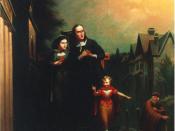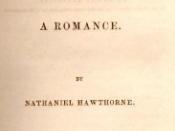Symbolism in literature is the deepness and hidden meaning in a piece of work. It is often used to represent a moral or religious belief or value. Without symbolism literature is just a bunch of meaningless words on paper. The most symbolic piece of work in American Literature is Nathaniel Hawthorne's The Scarlet Letter. Hawthorne's use of symbolism in The Scarlet Letter is one of the most significant contributions to the rise of American Literature.
Much of Hawthorne's symbolism is very hard to find but several symbols are also obvious. In the first chapter Hawthorne describes the prison as 'the black flower of civilized society'. The prison represents the crime and punishment that was incorporated in the early Puritan life. He also contrasts the prison with the tombstone at the end of the novel by suggesting that crime and punishment bring about the end of civilized life. In the same chapter he describes the overgrown vegetation of weeds around the prison.
The weeds symbolize how corrupt civilization really is. He also points out a positive symbol, the wild rose bush. This represents the blossoming of good out of the darkness of all civilized life.
The most important symbol which is carried throughout the novel is undoubtedly the scarlet letter A. It initially symbolizes the immoral act of adultery but by the end of the novel the 'A' has hidden much more meaning than that. The 'A' appears in many other places than on the chest of Hester Prynne. It is seen on the armor breastplate at Governor Bellingham's mansion. At night while Dimmesdale is standing on the scaffold he sees a bright red letter A in the sky. While Pearl is playing near the bay shore she arranges some grass in the form of an A on her own...


